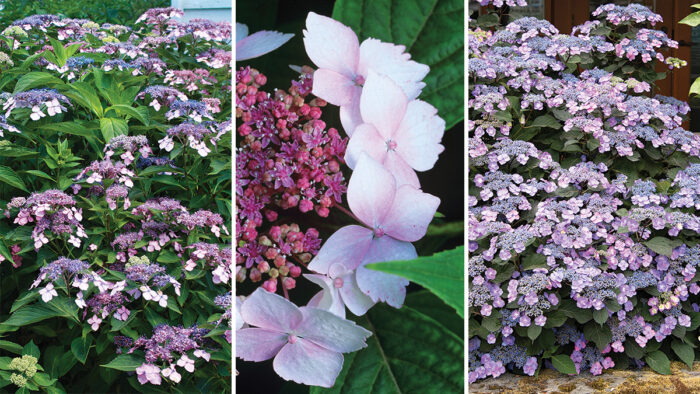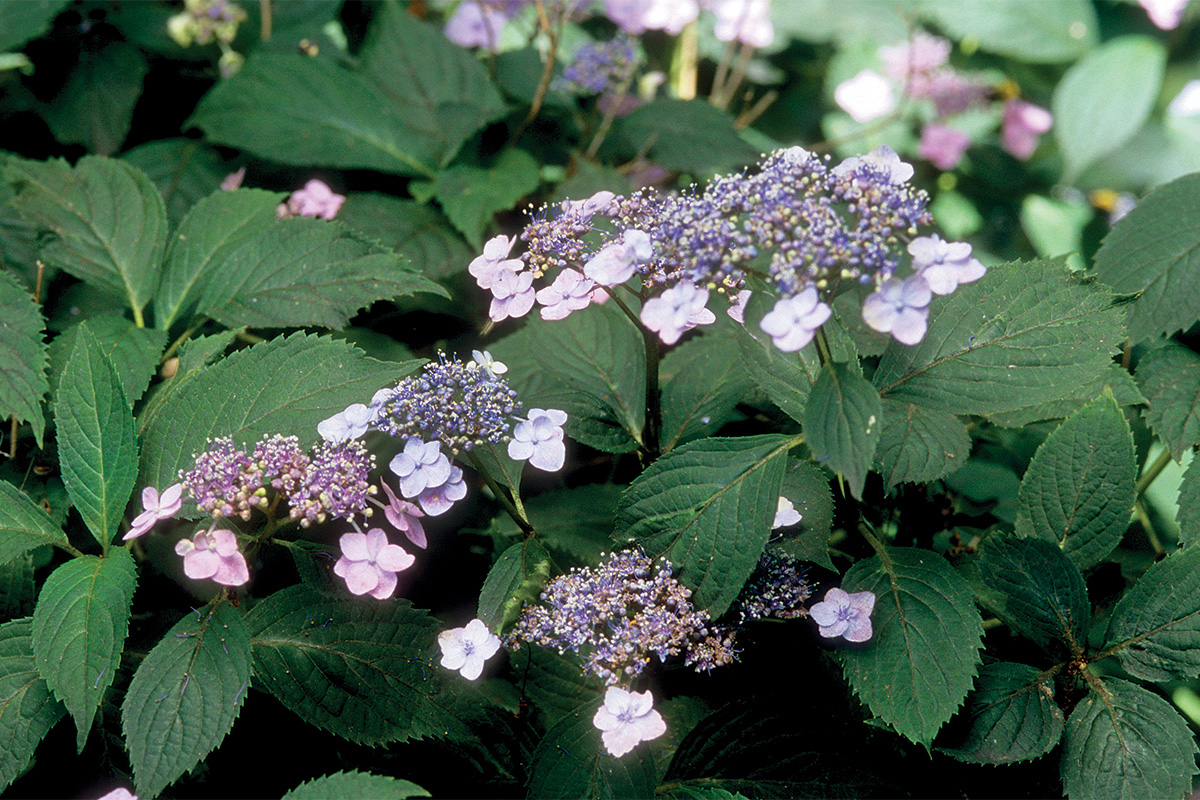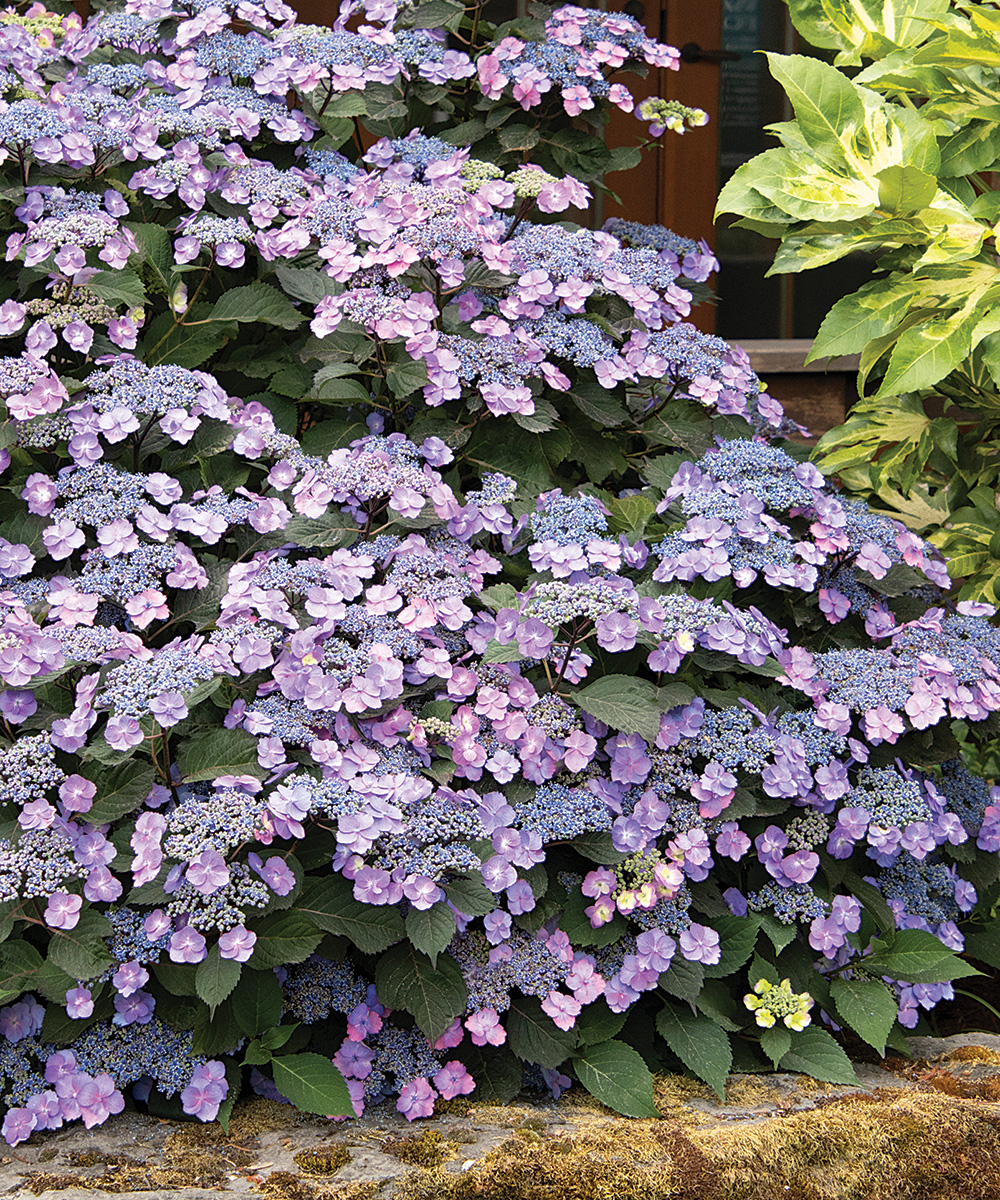
Many gardeners have started to look more closely at mountain hydrangeas. This species is native to the mountainous regions of Korea and Japan, an environment that produces plants that are slightly hardier than most bigleafs, which are native to the milder Japanese seaside.
The large flowers of bigleaf hydrangea (Hydrangea macrophylla, Zones 5–9) have long been the pride of residents and the envy of tourists where I live in southern Rhode Island. These shrubs are beautiful when they flower, but their bloom is not always reliable. When I started growing hydrangeas twenty years ago, bigleafs produced flowers more often than not. That trend has changed. In the last few decades, I have observed that lack of flower production on bigleafs has become more common. I blame the temperature fluctuations we now more commonly experience during the dormant season.
With the climate changing, it seems that winters are getting warmer, with some extremely mild days that can mess with a plant’s dormancy. These temperature extremes can cause the sleeping bigleaf flower buds to begin blooming, then wither when cold temperatures return. This is also a problem in spring, when a late frost can kill emerging buds, resulting in no flowers for the season.
Why mountain hydrangeas may be a better bet
Mountain hydrangeas stay dormant longer and bloom later than bigleafs, so they are far less susceptible to temperature extremes killing off tender buds. They also have another advantage in their smaller leaves. All plants transpire, or lose water through their foliage. The bigger the leaf, the more water the plant will lose. If your bigleaf hydrangeas are wilting on a hot summer day, it’s because the foliage is losing water faster than the roots can draw it in to replenish the leaves. With their smaller leaves, mountain hydrangeas are more tolerant of harsh sun and heat, making them a better fit for warmer areas like the South. And if you’re craving those beloved blue hydrangea flowers, mountain hydrangeas, like bigleafs, are able to bloom blue or pink based on soil chemistry. Learn how to change the flower color of your hydrangea shrubs.
With their reliable bloom and delicate flowers, mountain hydrangeas can make a great addition to any garden—even ones where bigleafs are struggling. Here are a few standout cultivars known for their stellar, consistent performance.
Learn more about growing hydrangeas:
Lacecap and Mophead Blooms—What’s the Difference?
A Quick Review of Hydrangea Pruning
About Mountain Hydrangeas
(Hydrangea serrata and cvs.)
Zones: 4–9
Size: 3 to 5 feet tall and wide
Flowers: Lacecap blooms in early to late summer
Conditions: In the North, some varieties can take full sun, while others require shade; in the South, all require partial to full shade. Provide well-drained soil with average moisture; avoid gravelly or sandy soil.
Pests and diseases: These plants have no serious pest or disease issues. They may fall prey to black spot or powdery mildew with too much water, as is the case with all hydrangeas.
Native range: Mountainous regions of Korea and Japan
Best Mountain Hydrangea Plant Varieties
‘Bluebird’ is a classic for a reason

Name: H. serrata ‘Bluebird’
Zones: 6–9
Size: 5 feet tall and 4 feet wide
‘Bluebird’ is a mountain hydrangea staple; the Royal Horticultural Society of England gave this plant its award of merit in 1960, and it has been a solid performer ever since. It has an upright, dense form and prefers partial shade. Flowers tend to be a light blue, and at 6 to 8 inches wide, they are quite large. As fall approaches, the flowers start to turn upside down, showing their pink to reddish undersides. They make a lovely complement to crimson red fall foliage.
‘Shirofuji’ has bright white flowers that shine in the shade

Name: H. serrata ‘Shirofuji’
Zones: 6–9
Size: 3 feet tall and wide
‘Shirofuji’ has white, fully double lacecap florets, the color of which is unaffected by soil pH. Only the interior flowers and the eyes of the florets may pick up a blush of pink or a touch of blue. The flowers are 3 to 6 inches wide. This compact, mounding shrub produces very small, narrow leaves that turn a beautiful deep red in autumn. ‘Shirofuji’ enjoys morning sun and afternoon shade except in warmer zones, where partial to full shade is recommended. This compact cultivar is perfect for small spaces.
‘Midoriboshi Temari’ has stunning double flowers with pointed tips

Name: H. serrata ‘Midoriboshi Temari’
Zones: 6–9
Size: 3 to 4 feet tall and wide
‘Midoriboshi Temari’ blooms with sterile dainty double florets around fertile interior flowers that can be blue or pink. The florets are striking, with pointed sepals. This hydrangea may not be as showy as others, but the multitude of its tiny flowers makes it a standout in the garden. It also has a great wine-red fall foliage color. ‘Midoriboshi Temari’ is a midsize shrub with 3- to 6-inch-wide flowers and prefers partial shade.
For a larger specimen, turn to ‘Grayswood’

Name: H. serrata ‘Grayswood’
Zones: 5–9
Size: 6 feet tall and wide
‘Grayswood’ is one of the bigger mountain hydrangeas, and it has large flowers to match, which can be 6 to 8 inches wide. Its sterile flowers emerge white and surround fertile pink or blue flowers. The outer blooms change from white to pink as they age, and then turn a crimson red as the season progresses. In fall, the tips of the green leaves turn a brownish red. ‘Grayswood’ prefers partial shade, and it flowers later than other mountain hydrangeas—around midsummer—with a prolonged season of bloom.
Let’s Dance Can Do!™ is a reblooming hybrid that combines the best of both worlds

Name: H. macrophylla × serrata ‘SMNHSI’
Zones: 4–9
Size: 3 to 4 feet tall and 3 feet wide
It seems like a new hydrangea is introduced every other day. I’ve become skeptical in my later years, so it’s been hard for me to get excited about a new cultivar. Let’s Dance Can Do!™ just might change that. Most of the remontant, or reblooming, hydrangeas I’ve seen usually produce only a small amount of new flowers after the first bloom. But on this variety, I’ve seen as many as 30 flowers on the rebloom of relatively young plants, all of which are 4 to 6 inches wide. This is a lacecap, but there are so many sterile florets that it gives the appearance of a mophead. The result of a cross between mountain and bigleaf hydrangeas, it is extremely tolerant of cold and prefers partial shade.
‘O Amacha Nishiki’ is known for its distinctive variegated foliage

Name: H. serrata ‘O Amacha Nishiki’
Zones: 6–9
Size: 4 feet tall and wide
If you are a fan of variegated foliage, you need to try this variety. Above red stems, its leaves are green and speckled with some white and pink, which gives the foliage a silvery cast. The scattered randomness of the variegation is very attractive. ‘O Amacha Nishiki’ has 3- to 6-inch-wide flowers that are white when they open but then turn blue or pink. The foliage turns red in fall. Plant it in partial sun or light shade.
‘Blue Billow’ is a durable workhorse for sun or shade

Name: H. serrata ‘Blue Billow’
Zones: 5–9
Size: 4 feet tall and 5 feet wide
If you’ve consistently had trouble getting hydrangeas to bloom in your yard, I highly recommend trying the ultrareliable ‘Blue Billow’. I have two planted in my yard—one in almost total shade and one in full sun. They both produce abundant blue flowers without fail every year, even in winters when the temperature has gotten as low as –12°F. In addition to its long-lasting lacecap blooms, ‘Blue Billow’ has gorgeous burgundy foliage in autumn.
Tuff Stuff™ lives up to its name

Name: H. serrata ‘MAK20’
Zones: 5–9
Size: 3 feet tall and wide
Introduced in 2012, the aptly named Tuff Stuff™ has proven to be a very reliable cultivar. It produces 6- to 7-inch-wide deep blue to purple flowers with the right soil (above left). You can grow it in full sun, but it prefers afternoon shade. Flowers appear in late summer and age into shades of pink (above right). Autumn turns the foliage a rich red color. Tuff Stuff™ can also produce a small rebloom after its first flush fades.
Tiny Tuff Stuff™ packs a punch in a small package

Name: H. serrata ‘MAKD’
Zones: 5–9
Size: 1½ to 2 feet tall and wide
Tuff Stuff™ is already small, but Tiny Tuff Stuff™ is even smaller, only growing 1½ to 2 feet tall and wide, although I have seen some grow a little larger. The leaves are also narrower than those of Tuff Stuff™. The flowers, which reach about 4 to 5 inches wide, are smaller, but Tiny Tuff Stuff™ is much more floriferous. Like its parent, this variety grows in full sun to partial shade. Blue flowers age to maroon in fall, with deep red fall foliage to match.
Understanding the anatomy of lacecap and mophead blooms
Florets are the small blooms that make up a composite flower head, like those of hydrangeas. Fertile florets contain reproductive parts, whereas sterile florets do not. The difference between lacecap and mophead hydrangea flowers is the ratio of fertile to sterile florets. The outer florets on a lacecap are sterile and often have showy sepals (modified, petal-like leaves). The interior, smaller ones are fertile. The showier mopheads are made up almost entirely of sterile florets, with a few inconspicuous fertile ones mixed in, which are often not visible. Many hydrangea species are capable of both types of blooms, based on variety, but mountain hydrangeas produce only lacecaps unless hybridized.
Lacecap

- Mountain hydrangea (pictured)
- Bigleaf hydrangea
- Oakleaf hydrangea (H. quercifolia, Zones 5–9)
- Smooth hydrangea (H. arborescens, Zones 3–9)
- Panicle hydrangea (H. paniculata, Zones 3–9)
- Climbing hydrangea (H. anomala subsp. petiolaris, Zones 4–9)
Mophead

- Bigleaf hydrangea (pictured)
- Oakleaf hydrangea
- Smooth hydrangea
- Panicle hydrangea
When to prune hydrangeas depends on bud set
For many gardeners, pruning hydrangeas can be a daunting task. Knowing when your plant forms flower buds is the key to successful pruning and thus better flowering. I can’t count how often gardeners have asked me why their hydrangeas don’t bloom. Often it’s because the plants were pruned at the wrong time.
For a more comprehensive look at pruning hydrangeas, click here.

Hydrangeas that bloom on old wood
There are two kinds of hydrangeas: those that flower on old wood and those that flower on new wood. Hydrangeas that bloom on old wood include most bigleaf, mountain, oakleaf, and climbing hydrangeas. They start to form buds in late summer and fall for the following season, and they carry their buds through winter. So pruning these plants after the buds are formed and anytime until they flower the following summer will result in few flowers, and perhaps none. Even the reblooming hydrangeas carry buds from the previous year, so the same pruning advice applies to them. If I need to prune old-wood hydrangeas to control height, I usually do it at the end of July or early in August. This gives the plant time to grow, form buds, and harden off before winter. If you want to prune off dead wood in spring, I suggest you let the plant tell you what is alive or dead. Wait for the leaves to emerge in spring, then prune above the new growth, removing any stems that show no signs of life.

Hydrangeas that bloom on new wood
Hydrangeas that flower on new wood, such as panicle and smooth hydrangeas, are the most cold-tolerant and reliable flower producers in the Hydrangea genus. These hydrangeas set buds and flower in the same season, so their buds avoid the perils of winter. Autumn or early spring pruning will not affect flower production. It can be very difficult to tell whether your hydrangea blooms on old wood or new wood just by looking at it. It’s better to keep plant tags and know the species you’re working with.
Bob Aube is the founder and co-owner of Morningstar Nurseries, a wholesale nursery in West Kingston, Rhode Island.
Sources
Many of the varieties mentioned in this article are available for sale or special order from local garden centers. For those without local resources, the following mail-order nurseries may carry them:
- Hydrangeas Plus, Aurora, OR; 866-433-7896; hydrangeasplus.com
- Proven Winners, DeKalb, IL; 815-895-8130; provenwinners.com
- Burpee, Warminster, PA; 800-888-1447; burpee.com
Fine Gardening Recommended Products

The New Organic Grower, 3rd Edition: A Master's Manual of Tools and Techniques for the Home and Market Gardener, 30th Anniversary Edition
Fine Gardening receives a commission for items purchased through links on this site, including Amazon Associates and other affiliate advertising programs.

Gardener's Log Book from NYBG
Fine Gardening receives a commission for items purchased through links on this site, including Amazon Associates and other affiliate advertising programs.

Lee Valley Large Gardener's Wash Basket
Fine Gardening receives a commission for items purchased through links on this site, including Amazon Associates and other affiliate advertising programs.



















Comments
Log in or create an account to post a comment.
Sign up Log in